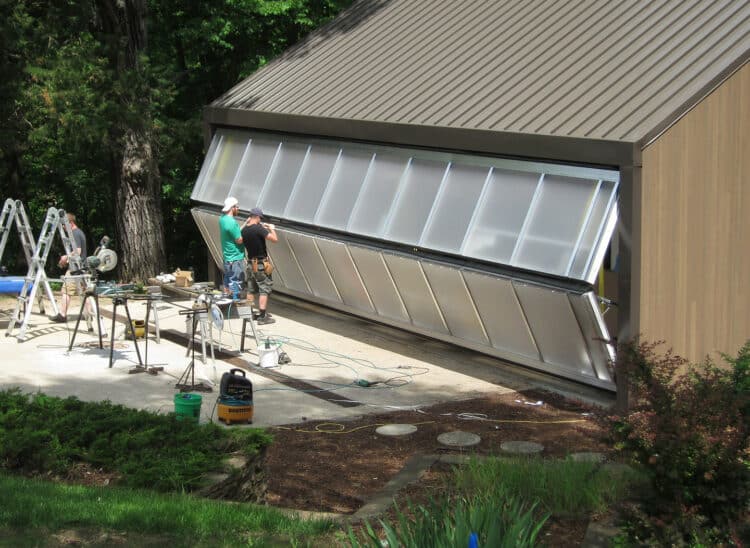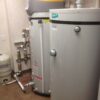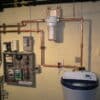
Have you felt the dread of waiting for a garage door to close, only to feel frustrated as it goes back up?
Do you get so frustrated that you start wondering about how to get your garage door back on track.
Well, here are some tips that might help you resolve your need for closure.
One has to remember that garage doors are often stubborn. Sometimes, you can’t really tell how wide it’s going to open for you. There is always a logical reason why your garage door is acting up.
It can be a bad track alignment, an obstruction on the door’s path, it could be an error with the settings or something to do with cables.
Some issues that only require replacing the battery are an easy fix. But issues about transmission or the spring might be a little complex. There are issues you can resolve yourself, and there are issues where you will need to hire a professional.
Garage doors rely on electricity, gears, and other mechanisms. These slowly wear out over time. It is important to know how to do basic maintenance and repairs so that you don’t end up paying a hefty sum for about 30 minutes of work.
This article will help you get your garage door back on track by proposing basic DIY repairs and solutions you have to try out before bringing in a professional.
Table of Contents
What are the signs a garage door needs fixing?
It goes without saying that you have to know your garage door before you can pin down what’s causing it to stop working properly. Basic checks including peering down beneath the door to make sure nothing is blocking it, then you could also see if anything is obstructing the sensors.
If your garage door is plugged in, look at the manual release cord, the limit setting, and the batteries. Still can’t pin it down? Here are a few signs to look out for that might help you figure out where to start:
Your garage door is sluggish in its response
This is more common with old garage doors. It doesn’t take as long to respond so there could be an issue with the opener or the transmitter.
It doesn’t close or open as smoothly as before
Take a look at how the door moves as it opens and closes. There could be a little bounce, the door could suddenly come to a stop, or it may be moving at an angle. Make necessary adjustments once you find something wrong with the door.
It’s making weird noises
If you hear a weird noise, then it may be a problem with the gears or the spring. A few ticks and squeaks are normal for every garage door but scraping sounds are usually not a sign of a good garage door.
This could mean that there is something loose. It could either be the door from the tracks or the wheel is loose, and the tracks got twisted. This can easily be fixed by tightening the tracks and the wheel.
However, if you hear a creaking sound, all you usually have to do is lubricate the bearings, wheels, hinges and gears with lubricating oil to keep them in optimal condition. Do this on a regular basis or as recommended by the owner’s manual.
Troubleshooting the parts of a garage door
A garage door has a lot of components and parts that allow it to function properly. If it starts showing signs of problems, then here is a list of parts to look out for and a solution that will help you get the part back in great working condition:
Wall station
The wall station is like a switch that will allow you to operate the lights and the door using buttons. Some models will even allow you to pair it with your phone so that you can operate the door and give access to people coming in and out of your house. It can even allow you to control the lights no matter where you are.
Try closing the wall station of the garage door opener. Place your hand on the inside of the wall station and press and hold down its interior until the door closes down. If the door shuts itself using this method, then the safety sensor is the problem.
The circuit boards might not be getting enough power, or it has short circuited due to moisture or a storm, or maybe it just needs cleaning. An issue with the sensors is easily remedied without needing the help of a professional.
Sensors
Sensors are devices to help avoid unnecessary accidents from happening. A broken sensor can lead to huge car damages, injuries, and possibly the death of a pet or family member. These sensors use infrared beams and are usually placed six inches off the floor and are aligned to each other.
The sensor serves as a safety device that will send a signal to your garage door when someone or something is beneath your door. This prevents accidents.
If you’re worried that your garage door sensor isn’t working properly, use a box or a board and place it underneath the door. This test will ensure that the safety feature is working properly and that no one gets hurt in case the doors start to go down.
After placing the box or the board underneath the door, try closing the door. If it opens up again before hitting the box, congratulations! Your sensor is working fine. If it didn’t stop and continued moving down, you may have to try and repair the sensor or at the very least, realign it.
Check the sensor light, if it shows any indication that the sensor has an obstruction, that might be the problem. Try fixing it by cleaning the sensor. A garage is a dirty place, and there are a lot of insects and dust floating around. Any of these could have affected the sensor.
Make sure to clean the sensor regularly so that anything blocking it is wiped away. Sensors have a glass surface similar to that of a camera. Any scratches on it will affect its performance.
You should also check if your sensor is getting enough power. If that isn’t the case, the sensor won’t be able to send the signal properly to your door. Failure to send a signal means your door isn’t going to close.
There might also be an issue with the sensitivity of the sensor. If this is the case, then you will just have to adjust its sensitivity. If it’s too high or too low, the door could malfunction. This is easily resolved by reading the owner’s manual, so you can reset the sensitivity or adjust it according to what you need.
If the door is still showing some problems even after cleaning the sensors, then the sensors may be misaligned. Some garage doors are heavy enough to loosen the screws around the sensor because of the vibrations it generates as it slides on the tracks. You can simply tighten the screws of the sensor back in place.
The doorway
If your garage door still won’t close despite the clean sensors, maybe the problem is there might simply be something blocking the doorway. A clear sign of this is if your door tries to close itself but opens again.
The obstruction doesn’t have to be big—and it can even be as small as a pebble
The limit adjust setting
The limit adjustment setting is where you regulate the how far the door moves or stops when it opens and closes.
If you’ve checked your sensors and their alignment, but the door still won’t close all the way through or it closes but opens back up again, the problem might lie in the door’s limit adjust settings. All you have to do is adjust them as you see fit.
Additional reminder: limit the door’s range through a few quick estimates. If the setting is higher than the actual limit, the door will hit the ground and reverse back up thinking it hit an object. It may take a few tries to get it right, but it may go by quicker if you refer to the manual.
The battery
For the transmitter to work properly, it needs to receive a decent amount of electrical power from batteries. So, once the batteries die, the transmitter can’t send a signal to the doors anymore. Most batteries needed to be changed every two years.
If the transmitter can still open and close the garage door, then you need only switch out the batteries for new ones. Remove them and place the battery in the correct position with the positive and negative signs facing the right way.
The tracks
Tracks can sometimes get misaligned. There are two types of tracks: The Standard Track and the Vertical Track. The standard track lifts the garage door and folds it horizontally above the garage while the vertical track lifts it outwards, away from the garage.
The door and the track have to be parallel to one another. If you see that they aren’t parallel to each other and there are rails that are bent and gaps, you have to call a professional.
Tracks can also be damaged due to the weight of the garage doors. Over time, tracks are bent, warped, or damaged because of the garage doors. If everything looks fine, then there may be an obstruction somewhere along the line of the tracks.
Negligence of damaged tracks will worsen the situation and put you at a higher risk for garage door accidents. In case it breaks off completely, you will have to purchase new garage door tracks and ask a professional for installation.
If your tracks are making a grinding sound as you operate and control them but there is no movement from the door, then the gear might be worn out. Consult the manual if you want to do a DIY repair. For most tracks, you will have to grab hold of the emergency catch and release it so that the door lowers.
Afterwards, disconnect the electrical power before working on the opener. It you can’t close the door, check the alignment of the sidetracks. One of them may be binding the door because of a slant. There must be an opening of at least 0.5 to 0.75 inches between the door and the track.
Make necessary adjustments of the clips using a screwdriver or a wrench.
The transmitter
When you’re out of range of the garage door, the transmitter will be unable to transmit the signals to your garage door. You should stay within a reasonable distance when operating and closing the door.
However, if you are in range but the door still won’t close, try checking the antenna. Any obstruction that can hide the antenna and prevent it from receiving any signals might be the cause for it not to work. It is also possible that the antenna might be damaged. If that is the case, you should call a technician to replace it.
You might also want to check the power of your remote. Remotes with LED lights tell you they’re working by lighting up when you press a button. If your remote doesn’t light up, you should try changing the batteries.
Although unlikely, it could be possible that your neighbor has the same transmitter frequency that you do. This means signals often get crossed and that is why your remote and transmitter are unable to communicate with each other. If this is the case, then you should change your garage door’s frequency and reprogram your remote.
The keypad
Some garages are locked and unlocked with a keypad with a passcode. If your keypad stops working, replace its batteries. Should that fail to resolve the issue, check out your owner’s manual so that you can reprogram it and repair the keypad.
The disconnect switch
If the motor of the garage door is running but your door isn’t moving, the disconnect switch is most likely on. Every garage door opener has this switch so that the owner can close and open the garage door manually in case there is no electricity.
In case it gets unhooked, the door will no longer work properly, and you will need to reattach to once again connect the motor to the door.
Lock mode
If your garage won’t open immediately, this might have been because you pressed down on the button for too long as you left your garage. This isn’t anything serious. This feature exists in almost all automatic garage doors.
You can activate this by holding the lock button of your remote for a few seconds. Once activated a simple click will not open the door. Instead, you will have to do the go through the same process from when you locked it. By pressing the button for a few seconds, lock mode will be deactivated.
The breaker box
If the door won’t open using the switch on the inside of the garage or with the controller but lights and electricity are running fine, there might be an issue with the breaker.
Check the breaker box. If the breaker for the garage doors was tripped, simply flip it back but if it shorted out, you are going to have to replace them by turning them off and only turning them on once you’ve made the replacements.
If that didn’t work, remove the cover plate of the motor and check for loose wires that may have been cut or unplugged. Turn off the breaker while checking on the wires so that you don’t get an electric shock.
The springs and cables
To ensure a garage door closes safely and smoothly, it comes with a tension spring and cables. As times goes by, the spring can break, resulting in your door closing up fast and hitting the ground with a loud bang.
In cases like this, it requires professional help is recommended because the pressure and tension on the cables is mounting, resulting in the higher likelihood of them snapping off. This is dangerous because tightly bound cables that snap can move quickly and hurt someone. The cables must be inspected regularly to avoid such accidents.
The garage door seal
Sometimes weatherstripping found below the door deteriorates naturally over time, inviting water, insects, dirt, and debris inside the garage space. You can always go to your local store and replace the weatherstripping.
The pricier weatherstrips come in garage-specific kits with adhesive and a caulking gun for extra sealing.
If you are not going buy a custom kit, cut a little from the weathering strip to fit in to your garage door’s width. Then, with the garage door slightly open from the frame, fold the weathering strip into a U-shape and then slide it into the bottom of the garage door.
When is it time to call a professional?
If everything you’ve tried has failed, then it may be time to call someone who is qualifies to take a look at your garage door. There’s no harm in admitting you can’t solve this on your own.
You are not a mechanic. And if you try to fix tightly wound torsion springs, you could end up getting yourself or other people hurt. In cases that can’t be fixed with DIY methods, calling a skilled and reliable professional to do the work for you is safest.
They also know best when you want to know how to get your garage door back on track.
How do you manually reset a garage door?
There are times when despite your best efforts, you are unable to get a garage door to open. This may either be caused by a faulty power line, a blackout, extremely cold weather conditions, or any other reason that makes a garage door malfunction.
Most garage doors come with an emergency cord that the owner can pull on in order to open it manually. Follow these steps so that you can manually open your garage door:
1. Make sure the door is in a “down position”
If you try to do this while the door is up, the entire garage door could crash down because of the faulty spring that isn’t letting it open or close properly. In the case of a garage door in an “up” position, contact a professional to help get it down for you.
2. Pull on the garage door’s emergency release cord
This is the part of the garage door that is hanging from the door’s trolley. As the door opens and shuts, the trolley moves along with it and through a point, it connects to what is known as an opener carriage.
This opener carriage is how the door moves along its rails or tracks. By pulling on the emergency release code, you are able to slide the door without needing an automated carriage. You can now manually move the garage door.
3. Place it back to a “down position”
After using the garage door, you have to slowly move it back down and reengage the door’s automatic opener.
4. Move the cord towards the door
A trolley can either be connected or disconnected. Each position changes where the spring lever is located. A disconnected spring lever means it is extended and you can do this by pulling the cord away from the door.
A connected spring lever means it is being squeezed tight or compressed. You can do this by pulling the cord away from the motor instead of the door.
5. Establish a reconnection between the trolley and the open carriage
One way of doing this is by using a connected spring lever and by sliding the door until you reengage the point of attachment. Alternatively, you can also use the remote. The opener carriage will automatically reconnect to the trolley.
Wait for the sound of a loud click to ensure they’ve reconnected correctly.
Frequently asked questions
What do I do if my garage door is open and won’t close?
You could still follow the same process as above and check the garage door’s sensors and track so that you can figure out the root of the problem. It’s possible that the batteries in your remote are dead and have to be replaced.
Another reason why it won’t close is that something is blocking the sensors and preventing them from giving the garage door the “all clear” to close.
Then again, sometimes there is an obvious solution. Some garage doors have a handle that allows someone to lock it from the outside. Someone may have accidentally turned the handle and locked the door.
I have a garage door and why won’t it close properly during cold weather?
If this is a seasonal thing that happens during the cold weather, then your safety sensors may just need some cleaning, or your tracks need a little lubrication.
Safety sensors are usually built to last despite the weather, but sometimes it can be sensitive to specific temperature ranges. Here are a list of possible problems that come with a sensor and cold weather:
Condensation
Sensors can have condensation form within them. Luckily, this is an easy fix. One of the best ways to tell that your sensor has condensation is that it starts to look cloudy. All you have to do is give them a good wipe so that your garage door will close normally.
Metal has changed size and misaligned them
As we were taught back in school, metal reacts differently to different temperatures. In hot temperatures, it expands, but in cold temperatures, it contracts. There may be a subtle shift in the alignment of the sensors if metal is the cause they aren’t working.
Use your phone camera so that you can see the emitter beam coming from the sensor. Realign as needed so that the emitter hits the receiver via an emitter beam.
Lubricant has frozen up
There is lubricant that is suited for cold weather. This means it doesn’t freeze up when exposed to below freezing temperatures. It’s also possible that old lubricant starts to clump together eventually.
Spray lubricants made out of silicone are highly recommended because of their versatility; they can be used no matter what the season is.
The sensors need a hard reset
Sometimes, turning the system on and off can give you the results you’re looking for. You can easily do this by plugging the entire garage door system out of the wall and then plugging it back in after a few days (or hours).
Conclusion
Most common garage door problems don’t take a genius or mechanic to fix. But sometimes, you may eventually have to admit that you need to replace the entire garage door with a new one. It is better to prevent accidents instead of picking up after an accident.
To avoid regular breakdowns of your garage doors, you have to give it some much-needed maintenance so that wear and tear is minimized, and it lasts longer without sacrificing anything for quality.
Never hesitate to reach out to a professional when it comes to fixing a broken garage door because they definitely know how to get your garage door back on track. It’s better to have a professional working on it in case you make a mistake that makes the situation even worse. Be careful when handling faulty garage doors.


